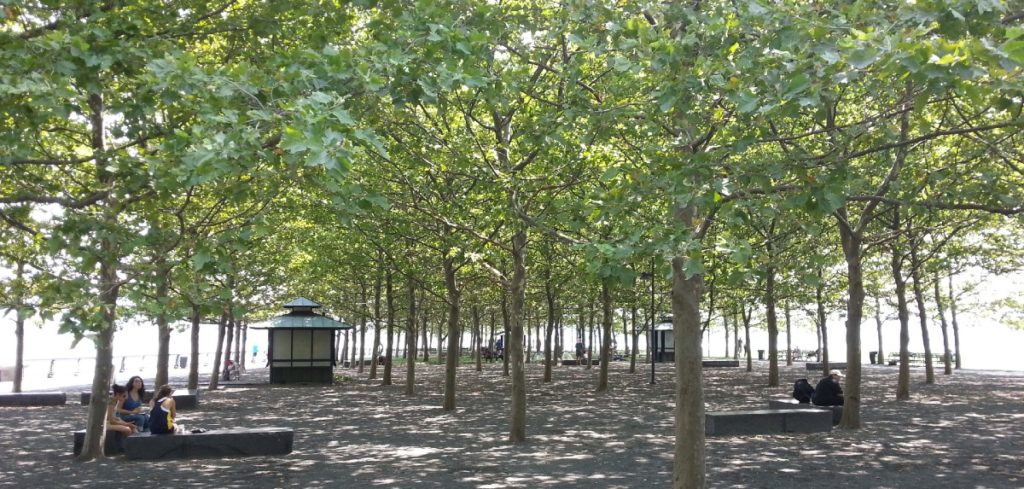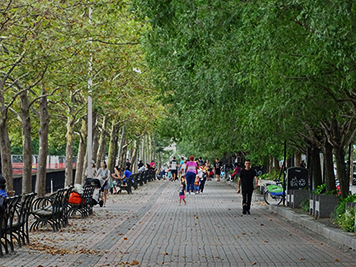Expanding a city’s tree canopy coverage is an essential strategy to combat climate change.

The last significant addition to Hoboken tree canopy coverage was at Hoboken’s South Waterfront in the 1990s.
FBW | October 16, 2024
The Urban & Community Forestry Program of the U.S. Department of Agriculture Forest Service has awarded the City of Hoboken a $1 million grant aimed at expanding and maintaining the City’s tree canopy. The project will plant 300 new and replacement trees in public spaces and provide training and employment opportunities for local residents. To carry out this project, the City will establish a Division of Urban Forestry.
Shade trees are a critical component of a city’s infrastructure. In addition to their aesthetic value and ability to lower temperatures, they provide many other benefits. Through photosynthesis, shade trees sequester carbon dioxide and provide oxygen, essential to human life. Large trees have the capacity to take up significant volumes of water, reducing storm-water runoff and providing flood resiliency. They also remove pollutants from the air, including carbon monoxide, nitrogen dioxide, sulfur dioxide and particulate matter, improving air quality and creating a healthier environment. Expanding a city’s tree canopy coverage is an essential strategy for combating climate change.
The Fund for a Better Waterfront (FBW) has worked closely with landscape architects and has long been an advocate for canopy trees. FBW’s 1990 Plan for the Hoboken Waterfront proposed continuous rows of shade trees at the water’s edge. Recently, FBW worked closely with the City of Hoboken, successfully pushing for continuous rows of canopy trees as part of the Sinatra Drive Project that will be built next year. Unfortunately, the City has ignored FBW’s 2023 proposal for a wide tree-lined public median traversing 15th Street as part of the North End Redevelopment Plan.
Built in the late 1990s, the award-winning Pier A Park included a grove of 97 London plane trees, and the promenade from Newark to Fourth Streets features another 200 canopy trees. Later, as part of the 9-11 Memorial, 56 ginkgo trees were added to Pier A. Unfortunately, since that time, the City of Hoboken has squandered opportunities to further increase its tree canopy:
- Opened in 2007, the north end of Maxwell Place Park is an expanse of concrete with few trees.
- The London plane trees at Maxwell Place Park were uprooted during Superstorm Sandy and again after Hurricane Isaias due to inadequate soil volumes and depths.
- Completed in 2008, Castle Point Park is largely devoid of tree coverage.
- When Sinatra Park was rebuilt in 2013, the London plane trees along the walkway were replaced with small ornamental trees, a number of which have died.
- Excessive use of sodium chloride rock salt during winter months along the walkway at the South Waterfront led to the loss of scores of London plane trees.
- The recently built parks on the western part of town have limited shade tree coverage.
Google’s Environmental Insights Explorer (EIE) provides data on tree canopy coverage for municipalities to assist in developing climate action plans. EIE’s website shows tree canopy coverage for Hoboken at 13 percent, lagging behind most other urban areas. The U.S. average is 27 percent. New York City is at 19 percent and Pittsburgh, Pennsylvania ranks among the highest with 44 percent.
This recent generous federal grant is an opportunity for Hoboken to prioritize canopy trees and greatly expand their coverage. To be successful, the City needs to learn from its past mistakes. Proper soil volumes for canopy trees is essential for them to thrive and have long lives. Selecting shade trees varieties that can survive in an urban environment and are appropriate for our ecosystem are also key.
Much of Hoboken’s existing tree canopy was established in an earlier era at Church Square, Stevens, Elysian and Columbus Parks, all built more than 100 years ago.
The rays of the sun heat up a city’s roadways, sidewalks and rooftops. The cars, buses and trains generate yet more heat. As temperatures rise, air conditioners pump even more warm air into the outdoors. The result of all this has been called the heat island effect. For urban dwellers, which includes 80 percent of the U.S. population, the heat island effect can increase temperatures by 8 degrees Fahrenheit or more.
A study published in Nature Medicine determined that nearly 62,000 people died in heat-related deaths in Europe in the summer of 2022. The Lancet published research showing that increasing tree cover to 30 percent, in effect doubling the existing coverage, could reduce heat-related deaths in European cities by 40 percent.
Related Articles
Roots Over the River – Landscape Architecture
Sustainable trees for sustainable cities – Arnoldia
Related Links
As climate change heats up our planet, Hoboken falls short on its tree canopy coverage
On Arbor Day, taking inventory of Hoboken’s canopy trees
Our proposal for a public greenway along 15th Street
An innovative planting technique for urban trees
Making the “green circuit” greener along Hoboken’s waterfront
Hoboken’s model for trees in urban design
In praise of London plane trees in London . . . and in Hoboken
The transformation of Hoboken’s waterfront
Mapping New York City’s trees


